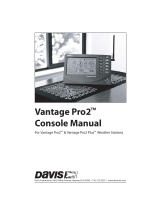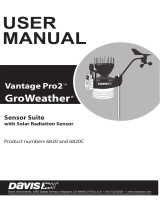Page is loading ...

1
Soil Moisture Sensor & Multi-Purpose Temperature
Probe Installation Instructions
For Wireless Leaf & Soil Moisture/Temperature Stations
The WATERMARK Soil Moisture Sensor and the Multi-Purpose Temperature
Probe are for use with the Vantage Pro2 Wireless Leaf & Soil Moisture/Temperature
Station, #6345. Please refer to your Wireless Leaf & Soil Moisture/Temperature
Station manual for more information on how to install and use the sensors.
Installation Procedures
Connecting the Sensors
• To extend the sensor cables, see “Extending Sensor Cables” on page 4.
• To use a temperature probe for temperature compensation of a soil moisture
sensor, install the sensor pair in corresponding connectors: 1 & 1, 2 & 2, 3 &
3, and 4 & 4.
• If no soil temperature probe is used, the station will use a default temp of
75°F (24°C) to compensate the soil moisture readings.
• If you are installing a temperature probe that is not providing temperature
compensation for a soil moisture reading, do not use a connector that matches
to any installed soil moisture sensor.
• If a soil moister / temperature sensor pair do not use matching connectors, the
soil moisture reading can be off as much as 1% for every 1
°F (0.5°C) error in
the soil temperature.
1. Run the sensor cables up through the grommets on the bottom of the station
housing.
2. Connect soil moisture probes to the SOIL connectors.
3. Connect the temperature probes to the TEMP connectors.
Cable Clam
p
Mount
Leaf Wetness
Sensor Cable
Rubber
Grommets
SENSOR
SENSOR
INTERFACE
INTERFACE
MODULE
MODULE
Cable Clamp
Cable Clam
p
Screw
Temperature Moisture
1 2 3 4 1 2 3 4
Soil Moisture
Sensor Cable
Temperature
Probe Cable
Sensor Cables Enter Station
Housing Through Grommets
Connecting Sensor Cable to
Terminal Block

2
4. Secure all sensor cables through the provided cable clamps and then secure the
mounts by driving a screw through the clamp into the cable clamp mounts
located above the grommets.
Before “Planting” the Sensors
If you can, soak soil moisture sensors overnight in water before installing them.
• Always “plant” a wet soil moisture sensor.
• If time permits, wet the soil moisture sensor for 30 minutes in the morning and let
dry until evening, wet for 30 minutes and let dry overnight, wet again for 30 min-
utes the next morning and let dry again until evening. Soak over the next night
and install wet. This will improve sensor response during the first few irrigations
or waterings.
“Planting” the Sensors
1. Make sensor access holes to the depth required with a 7/8” diameter rod.
• Make a hole for the soil moisture sensor and a sepa-
rate adjacent hole for the temperature probe.
• For very coarse or gravely soils, an oversize hole of 1”
to 1 1/4” may be needed to prevent abrasion damage
to the soil moisture sensor membrane. In this case,
you will need to “grout in” the sensor with a slurry
made from the sample soil to get a snug fit in the soil.
2. Always install sensors in the active root system of the
crop with a snug fit in the soil.
CAUTION: In gravelly soils and with deeper sensors, you must
use extra caution to install the soil moisture sensor
without damaging the membrane.
• Lack of a snug fit is the biggest problem in obtaining
good soil moisture sensor readings.
• The ideal method of making the access hole is to have
a stepped tool. This makes an oversize hole for the
upper portion and an exact sized hole at the bottom
where the sensor is located.
2-1/2" (64 mm)
7/8" (22.5 mm)
Cold rolled steel,
round rod
1-1/4" (32 mm)
approximate
diameter
Overall length
variable
Stepped Sensor Installa-
tion Tool

3
3. Fill the hole with water and push the sensor down into the hole so it bottoms out.
• A length of 1/2” Class 315 PVC pipe (pipe inside diameter = 0.716”, 18.18mm)
fits snugly over the sensor collar and can be used to push the sensor. A good snug
fit in the soil is important.
4. You can solvent weld the 1/2” Class 315 PVC pipe to the sensor collar for easier
installation and removal. Use a PVC/ABS cement (IPS Weld-on #794 or equiva-
lent).
5. Carefully backfill the access hole with soil to eliminate any air pockets which
could allow water to channel down to the sensor.
6. If you are using temperature sensors, install the temperature sensor next to the
soil moisture sensor.
Note: Soil moisture sensors will provide better accuracy after one or two irrigation cycles, during which
time they “break-in” and acclimate to the soil conditions.
“Planting” Sensors in Turf or Lawns
1. Cut a slight “V” shaped trench about 5” wide at the top, and about 6” deep into
the turf, and about 6” long.
2. Lift out the turf plug piece you just cut.
3. Press the sensors into the soil at about a 45 degree angle into the side of the
trench to set the sensors about 3”-5” below the soil surface. Make sure they are
set snugly in the soil.
4. Replace the plug removed from the trench and compact it back into place. It will
repair itself in short order.
5. Run the wires to the Soil Moisture Station and connect them as described in
“Connecting the Sensors” on page 1.
Sensor
Wires
Tape
1/2" Class 315 PVC Pipe
(inside diamter = 0.716",
18.18mm)
Pipe welded to
sensor collar with
PVC/ABS cement
Soil Moisture
Sensor
PVC Pipe Welded to Soil
Moisture Sensor Collar

Product Numbers: 6440, 6470
Davis Instruments Part Number: 07395.158C
Soil Moisture Sensor & Multi-Purpose Temperature Probe Installation Instructions
Rev. C Manual (2/25/05)
This product complies with the essential protection requirements of the EC EMC Directve 89/336.
3465 Diablo Avenue, Hayward, CA 94545-2778
510-732-9229 • Fax: 510-732-9188
E
-mail: [email protected] • www.davisnet.com
6. If you withhold irrigation for several days and allow the soil to dry down a bit,
you should see the soil moisture readings start to creep upward.
7. Usually, you will not need to water turf until the soil moisture reading is around
25-40 centibars at the recommended 3”-5” depth.
Extending Sensor Cables
The soil moisture sensor and the temperature probe both come with a 15’ (4.6 m) cable.
• If additional wiring is required, up to 1000’ (300 m) of additional wire can be
spliced onto the sensor wire.
• The additional wire must be fully waterproof.
• We recommend using #18 gauge wire with UF insulation, and using a 3M
Scotchpak or Duraseal heat shrink splice connector.
Note: Avoid long wire runs near power cables. The transient currents can affect the small current used
to read the sensors.
Removing the Sensors
1. When removing sensors prior to harvest in annual crops, it’s a good idea to do
this just after the last irrigation when the soil is moist.
2. Do not pull the sensor out by the wires. You may have to dig out, at least par-
tially, any sensors more than 12” deep or any sensors in dry soil. Careful removal
prevents sensor and sensor membrane damage.
3. When sensors are removed for winter storage, rinse the sensors in water to clean
them, let the sensors dry, then store the sensors in a clean, dry location.
Contacting Davis Instruments
(510) 732-7814 Technical Support, Monday – Friday, 7:00 a.m. – 5:30 p.m. Pacific Time.
(510) 670-0589 Fax to Customer Service or Tech Support.
[email protected] E-mail to Technical Support.
[email protected] General e-mail.
www.davisnet.com Copies of User Manuals, Spec Sheets, and Application Notes are
available on the “Support” page. Watch for FAQs and other updates. Subscribe to the e-
newsletter.
/

